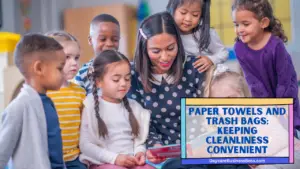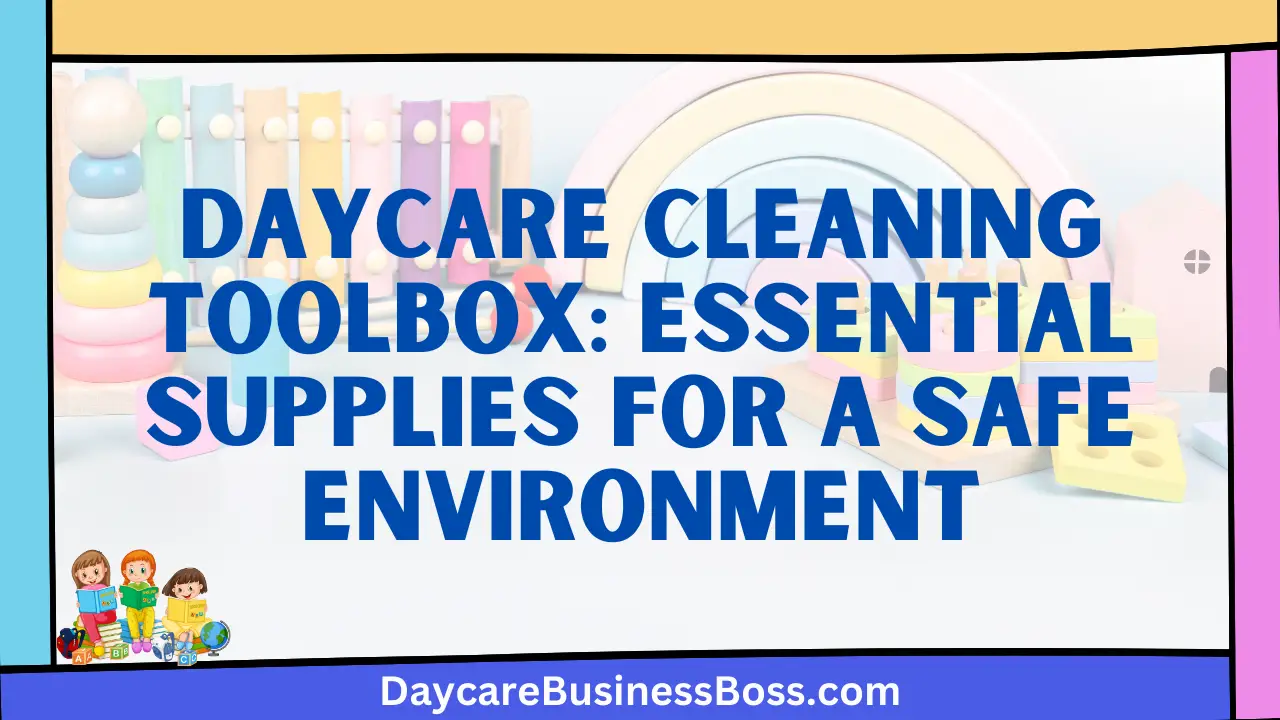Maintaining a clean and sanitary atmosphere is critical in the field of childcare. The health and well-being of young children are dependent on rigorous cleaning. The importance of good cleaning techniques in daycare environments cannot be stressed, from keeping surfaces germ-free to establishing a safe area for play and learning. A detailed childcare cleaning supply checklist is an important tool in this regard.
The most useful tools for daycare cleaning include disinfectant wipes, bleach, non-toxic cleaners, paper towels, trash bags, a broom, a mop, a vacuum, and gloves. Together, they ensure a safe and clean environment, prioritizing the health and well-being of the children under care.
This article discusses the need for a well-prepared cleaning supplies checklist for daycares, listing the key elements that contribute to the establishment of a clean and safe haven for children. You can ensure that children thrive in an environment that emphasizes their health, safety, and general development by methodically collecting the correct cleaning tools and materials.
Disinfectant Wipes: Shielding Against Germs and Bacteria

Disinfectant wipes are essential for maintaining perfect cleanliness standards in daycare centers. Because of their unrivaled simplicity and efficacy, these flexible tools are an essential component of any comprehensive cleaning plan. These wipes contribute considerably to the overall health and well-being of the daycare environment by quickly removing germs, bacteria, and viruses from surfaces that frequently come into touch with children.
Disinfectant wipes, which are infused with potent antibacterial chemicals, serve as a formidable line of defense against the rapid spread of dangerous infections. Their ability to quickly eliminate viruses provides a vital buffer against future outbreaks, protecting both the children in the daycare and the caregivers in charge of their well-being.
These wipes provide a simple and economical approach to maintaining an environment that is constantly free of hazardous microbes, from routinely handled toys to frequently touched doorknobs. Disinfectant wipes reduce the danger of diseases spreading among the daycare’s young residents by targeting high-touch areas prone to contamination.
Incorporating disinfectant wipes into daycare center cleaning routines not only improves children’s physical health but also provides parents and guardians with a sense of security. These wipes demonstrate the facility’s dedication to providing a safe and caring environment for the children under its care.
Read more about: Safe, Clean, and Nurturing: The Key Elements of Family Daycare Inspection
Bleach: A Powerful Defense Against Contaminants
Bleach is an undisputed cleaning agent champion, known for its remarkable power in removing stubborn stains, battling mold, and eliminating hazardous bacteria. Bleach appears as a vital ally in the dynamic milieu of daycare centers, where spills, mishaps, and messes are commonplace. Its adaptability makes it a useful tool for preserving the cleanliness and safety of these busy areas.
The special qualities of bleach are highlighted in the complicated dance of childcare. It changes into a potent sanitizing and disinfection agent when diluted to proper concentrations, creating an atmosphere that is not only visually clean but also hygienically safe for children to explore and engage in. Because bleach targets and neutralizes potentially hazardous microorganisms, it ensures that surfaces often touched by children are free of disease-causing substances.
However, using bleach responsibly is essential. The same power that makes it useful needs caution in its use. To reap its benefits while minimizing potential hazards, proper dilution ratios and attention to safety rules are critical. The careful application of bleach emphasizes the significance of striking a balance between efficacy and safety.
The strategic use of bleach becomes a vital part of the caretaking repertoire in childcare environments, where the well-being of children takes primacy. Its capacity to tackle not only visible messes but also the invisible threat of pathogens is a feature that caregivers and parents appreciate. When bleach enters the arena, it instills confidence in a daycare’s dedication to delivering a clean, secure, and nurturing environment for every kid under its watchful eye.
Non-Toxic Cleaners: Balancing Effectiveness and Safety
When the safety of children is prioritized, the need for non-toxic chemicals in the field of daycare cleaning becomes abundantly evident. These cleaners are a necessary foundation, ensuring that the nurturing atmosphere is as safe and pure as the objectives behind it. These compositions, meticulously crafted, strike an ideal balance between efficiency and gentleness, revolutionizing the conventional notion of cleaning.
Non-toxic cleaners take center stage in a perfect symphony of environmental stewardship and human wellness. Their excellent formulation not only thoroughly removes filth and grime, but it does so without the potentially hazardous side effects that are typically associated with traditional chemical-laden alternatives. These cleaners are essential in a daycare situation, as children’s natural curiosity encourages them to interact with a variety of surfaces, toys, and items.
Non-toxic cleaners represent the spirit of responsible caretaking by embracing an innovative formula. The significant reduction in harmful chemicals transforms them into beacons of safety, protecting not only the precious lives entrusted to childcare providers but also the fragile ecosystems over which we are custodians. The careful use of non-toxic cleaning demonstrates an establishment’s commitment to cultivating an environment that resonates with purity.
The versatility of non-toxic cleaners shines through, from washing down surfaces that serve as the canvas for inventive play to sterilizing toys that act as conduits for infinite creation. Their seamless incorporation into the everyday fabric of childcare cleaning routines heralds a new age in which the preservation of innocence and the sanctity of health coexist together.
Paper Towels and Trash Bags: Keeping Cleanliness Convenient

Paper towels and trash bags appear as two seemingly inconspicuous yet crucially necessary parts in the intricate tapestry of childcare housekeeping. Often overshadowed by more elaborate instruments, their plain demeanor betrays the critical functions they serve in maintaining hygiene and organization standards in these hectic workplaces.
With their simple appearance, paper towels reveal a unique dichotomy of convenience and cleanliness. Their disposable nature promotes a consistent approach to cleanliness, allowing caregivers to quickly address spills, messes, and the constant state of movement that is inherent in childcare environments. As youthful explorers mark surfaces, these towels act as silent sentinels, absorbing not only moisture but also dangerous germ vectors. They provide a gentle way to wipe little hands and faces, encouraging a sense of hygiene and well-being among the daycare community’s youngest members.
Trash bags, like paper towels, serve as unsung heroes, orchestrating a complicated waste management ballet. Their function extends beyond mere waste containment, as they act as barriers against contamination and the accumulation of unpleasant odors. Trash bags gently orchestrate a ballet of cleaning, smoothly whisking away the evidence of busy activity, from disposing of used paper towels to corralling soiled diapers and collected debris.
These unassuming items construct an elaborate story of cleanliness and organization inside daycare settings. The subtle presence of paper towels and garbage bags functions as a kind yet firm guiding hand while children explore, create, and learn, ensuring that the canvas upon which their experiences unfold remains spotless. The smooth interaction of these instruments emphasizes the fastidious attention to detail that characterizes a welcoming setting for young learners.
Read more about: Bridging Care: The Journey to Establishing a Dementia Daycare Center
Broom and Mop: Foundation of a Tidy Floor
The necessity of a clean floor goes beyond its aesthetic appeal and into the realm of critical importance for children’s safety. Within the dynamic canvas of daycare centers, where discovery and activity thrive, brooms and mops take on the role of unsung guardians, diligently ensuring both cleanliness and the well-being of young residents.
Brooms and mops are essential instruments that are woven into the daycare floor maintenance routine. The dependable broom becomes a harbinger of order, expertly sweeping away dust, filth, and the residues of fun-filled adventures. Its bristles act as conduits for change, transforming chaos into tidiness and therefore creating a safe area for children’s unfettered enthusiasm.
The mop emerges as a steadfast ally in the pursuit of sanitation, complementing the efforts of the broom. Its precise actions are not limited to removing filth; they also arrange the ejection of sticky residues that could otherwise endanger children’s health and safety. The tactile sways of the mop create a coordinated ballet, ensnaring not just dirt but also possible risks, ensuring that the floor remains an unobtrusive canvas for limitless exploration.
Daycare centers orchestrate a careful performance that mimics the essence of caring through a symphony of frequent cleaning and mopping procedures. The result of these efforts is a safe refuge where children can venture, play, and move around without encountering stumbling blocks like debris, allergens, or undesired residues of the day’s activities.
Vacuum: Tackling Hidden Allergens and Particles
Vacuuming transcends its ostensibly mundane character, growing into a significant undertaking that goes beyond plain cleanliness. Vacuuming is a vital tool in daycare environments, as every nook and cranny serves as the backdrop for children’s discovery and growth. It addresses hidden allergens and particles tucked beneath carpets, rugs, and upholstery.
Daycare spaces are often built for comfort and engagement, with enticing corners and play areas covered with materials that unintentionally act as hosts to dust mites and other invisible irritants. The vacuum takes on the role of a quiet hero here, using its power to discover and eliminate these hidden substances that have the potential to damage the health and well-being of youthful occupants.
The addition of a vacuum equipped with a High-Efficiency Particulate Air (HEPA) filter elevates this critical task. This innovative filter technology collects and entraps even the smallest of particles, ranging from dust mites to allergies, thereby improving indoor air quality. As the vacuum’s tremendous suction navigates the surfaces, it transforms them, making them not only visually clean but also intrinsically healthy.
Daycare centers demonstrate their dedication to providing a loving and protective environment for children by combining vacuuming and HEPA filtration. The interaction of these elements purifies the air they breathe, reducing the danger of allergies and sensitivities, which would otherwise limit their unbounded energy and inquisitiveness. By embarking on this road of comprehensive cleansing, daycare centers establish a sanctuary where the air is crisp and the unhindered growing of young minds and bodies is prioritized.
Gloves: Protecting Caregivers and Ensuring Hygiene

Gloves, which are often ignored in their importance, emerge as a crucial line of defense for daycare workers who perform the strenuous activities of cleaning and maintenance. These inconspicuous items provide a critical purpose, acting as a protective barrier between carers’ hands and potentially toxic cleaning chemicals. Gloves are unsung heroes in the story of cleanliness and well-being in daycare settings, where the safety and health of both workers and children are paramount.
The primary role of gloves is to create an impervious barrier that protects against the possible hazards offered by cleaning solvents. Their presence acts as a vigilant watchdog, ensuring that the hands responsible for developing young minds are safe. Simultaneously, this protective layer has an impact on the surfaces being cleaned, preventing the entrance of impurities that could inadvertently undermine the cleanliness being sought.
Beyond its practical utility, wearing gloves conveys a sense of expertise and diligence. The deliberate decision to wear gloves represents an uncompromising dedication to both hygiene and safety. Cleaning activities are transformed into perfectly completed rituals, emphasizing the daycare staff’s dedication to creating an environment that is not only visually pleasing but also safe from potential health hazards.
Gloves become representative of a holistic approach to daycare cleaning by setting this benchmark for hygiene and safety. They blend in perfectly with the loving and thorough mindset that characterizes these nurturing environments. When childcare workers wear gloves, they embody the values of responsible caregiving, creating trust in parents, guardians, and children alike.
Read more about: Creating a Welcoming Home Daycare: Supply Checklist and Tips
Frequently Asked Questions

What makes disinfection wipes such an important tool for daycare cleaning
Because of their capacity to effectively eradicate germs and bacteria from surfaces frequently handled by children, disinfectant wipes are crucial in daycare cleaning. These wipes include antibacterial chemicals that help prevent the transmission of infections, making them a quick and easy way to keep a germ-free environment. The use of disinfection wipes regularly minimizes the risk of infection among children and ensures a safer daycare setting.
What role do non-toxic cleansers play in creating a healthy daycare environment?
Non-toxic cleaners are important in daycare cleaning because they strike a compromise between efficacy and safety. These cleaners are designed to be gentle on the environment and human health while effectively removing dirt and grime without introducing dangerous chemicals. By using non-toxic cleaners, childcare facilities prioritize the well-being of children and employees while also maintaining a sanitary environment in which children can play without being exposed to hazardous substances.
What are the benefits of using gloves for childcare cleaning tasks?
For numerous reasons, gloves are a suggested addition to daycare cleaning activities. They act as a barrier between caregivers’ hands and potentially harsh cleaning chemicals, protecting staff health. Gloves also help to avoid cross-contamination by ensuring that surfaces are thoroughly cleansed without introducing extra contaminants. Daycare workers that wear gloves set a high standard of hygiene and professionalism, contributing to a safe and clean environment for children.
To learn more on how to start your own daycare checkout my startup documents here.
The information provided by DaycareBusinessBoss.com (“The Site”) is for general informational purposes only. All information on the Site is provided in good faith, however, we make no representation or warranty of any kind, express or implied, regarding the accuracy, adequacy, validity, reliability, availability or completeness of any information on the Site. Under no circumstance shall we have any liability to you for any loss or damage of any kind incurred as a result of the use of the Site or Reliance on any information provided on the Site. Your use of the Site and your reliance on any information on the Site is solely at your own risk.
This blog post is for educational purposes only and does not constitute legal advice. Please consult a legal expert to address your specific needs. Terms and Conditions. (https://daycarebusinessboss.com/terms-conditions/)

Meet Shawn Chun: Entrepreneur and Childcare Business Fan.
I’m a happy individual who happens to be an entrepreneur. I have owned several types of businesses in my life from a coffee shop to an import and export business to an online review business plus a few more and now I create online daycare business resources for those interested in starting new ventures. It’s demanding work but I love it. I do it for those passionate about their business and their goals. That’s why when I meet a childcare business owner, I see myself. I know how hard the struggle is to retain clients, find good employees and keep the business growing all while trying to stay competitive.
That’s why I created Daycare Business Boss: I want to help childcare business owners like you build a thriving business that brings you endless joy and supports your ideal lifestyle.


